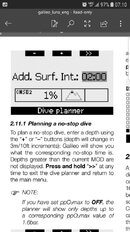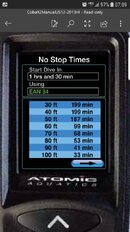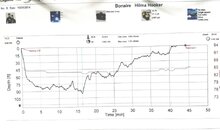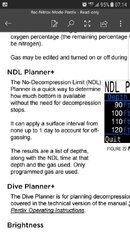- Messages
- 19,787
- Reaction score
- 18,645
- Location
- Philadelphia and Boynton Beach
- # of dives
- 1000 - 2499
After your 1st dive (or subsequent dives) when on your SI, go into the Plan (planning) mode. It will show you how much NDL you have for the depth you are planning for next dive at that specific time you checked. The longer your SI, the more the NDL increases. With every check you'll see this.
Generally 1 hour SI is a common practice, but you can use your computer planning mode to help make that final determination.
A one hour SI may or may not be the standard, depending on where you are diving, the depths, and the gas. We rarely do a 1 hour SI between the 2 morning or afternoon 2 tank dives in Southeast Florida. That is true for Jupiter, West Palm, and Boynton Beach.








